Home > Heather's Writing > Enabling Technologies 2
Enabling Technologies 2
I have lived with fairly severe ME/CFS for the last 11 years. I’m confined to bed for all but 3-4 hours per day, use a walker to get around the house and rarely go out. I'm quite sensitive to light, noise and smells. Adaptive technologies supplied by
the OT and physiotherapist compensate for some of these difficulties, as do various everyday technological solutions. I’ve already written about some of these in Meeting Place (see
Enabling Technologies).
Here are some more!
To help me rest
As mentioned above, I spend most of every day in bed. Here are some of the things that have helped to make this time more restful, meaning that I have more energy for doing things when I do get up.
Minimising back pain
Spending so much time in bed has led to constant back pain. This pain has been significantly eased by the use of D-shaped lumbar cushions. I have two of these: a smaller one that I use under my back when I’m lying down and a larger one that I use behind
my back when I’m sitting up in bed. You can buy lumbar cushions at larger chemist shops or on TradeMe. Look for ones that are fairly firm and provide good support. I also now spend several chunks of time every day lying on my front - causing my back
to bend the other way - and this has further reduced my back pain.
Drinking lying down
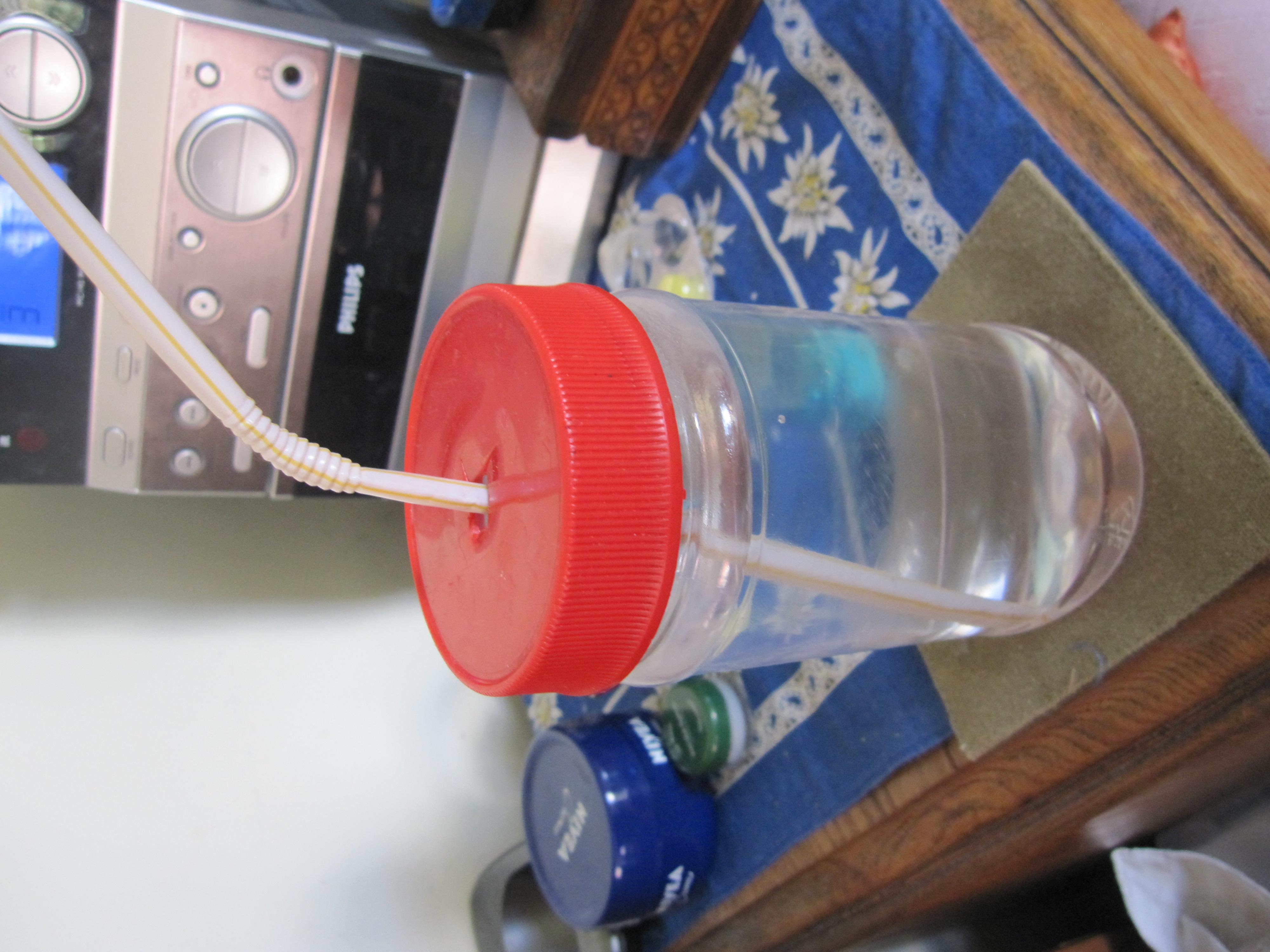 In order to drink while lying down (rather than disturbing my rest by sitting up) I use a cup fitted with a lid and a bendy straw. The lids are also useful when I transport the drinks from the kitchen to the bedroom: they prevent me from spilling liquid
on my walker and mean I make a much smaller mess if I happen to knock the cup onto the floor. For cold drinks I have constructed my own drinking jars from plastic food jars. I’ve cut a hole for the straw in the lid of an old 500g marmite jar. Simply
fill the jar with liquid, screw on the lid and pop in a straw.
In order to drink while lying down (rather than disturbing my rest by sitting up) I use a cup fitted with a lid and a bendy straw. The lids are also useful when I transport the drinks from the kitchen to the bedroom: they prevent me from spilling liquid
on my walker and mean I make a much smaller mess if I happen to knock the cup onto the floor. For cold drinks I have constructed my own drinking jars from plastic food jars. I’ve cut a hole for the straw in the lid of an old 500g marmite jar. Simply
fill the jar with liquid, screw on the lid and pop in a straw.
For hot drinks I mostly use insulated travel mugs. They keep my tea warm for around 2 hours, so I have no need to get up and make another cup before my next scheduled ‘up time’. Look for ones that have a large enough hole in the lid to poke a straw through
and have several layers of screw thread on the lid (otherwise the lids have a tendency to pop off when you drop them). I prefer ones with handles. I often remove the lid for 10-15 minutes after I return to bed to allow the drink to cool a bit: you need
drinks a bit cooler if you’re drinking through a straw rather than direct.
I also have a small silicone cover that I can pop over an ordinary china cup: this prevents spillage in transit but does have to be removed before I put the straw in. You can buy such covers from dx.com (search for “silicone cup cover”) for about $5
including postage.
Minimising noise disturbance
I live in an area with lots of infill housing, so more or less every day someone disturbs my rest by mowing their lawn or doing some DIY. To reduce the impact of this noise I have a pair of noise-cancelling headphones slung over my bedhead. When I turn
these on, they detect the sound around me and play a sound through the headphones that cancels it out: in effect most of the sound simply goes away. Headphones like these are quite expensive (mine cost around $400), but I have found them hugely helpful.
Mine are made by a New Zealand company, Black Box, from whom we have had excellent service. I also wear these headphones whenever I travel by car or plane. They’re best at canceling out steady noises like a lawnmower or washing machine: they‘re less
effective with barking dogs or other variable noise. When I’m finding the noise around me to be really disturbing I put in ear plugs as well: I keep these in a box beside my bed along with my medicines.
In order to minimise noise from people knocking on my front door (which opens straight into my bedroom), I have a laminated card stuck to the door at eye level, saying:
Welcome!
We may take some time to answer the door.
Expected Visitors: Please knock and wait
Couriers: Please knock once then leave your parcel on the chair
Emergency Services: Please knock, identify yourself loudly and wait for a response
Thank you!
Most people follow these instructions well and create minimal disturbance.
Keeping calm
I often rest better when I have something to muse on. Most of the time I'm listening to the radio, a podcast, an audio book or some music. I have a special playlist of music that helps me to relax when I’m fretful. A long-time favourite is
Birdsong Paradise
(from ucamusic.com), which plays the songs of the New Zealand bush.
My husband has also screwed a piece of clear perspex (A0 size, about 850x120mm) to the ceiling above my bed. I slide pictures and maps into this and change them every few months. I used to simply blutak pictures to the ceiling but they had a tendency
to fall back onto the bed: now they stay where they’re put! The pictures give me things to think about and places to imagine myself into :-)
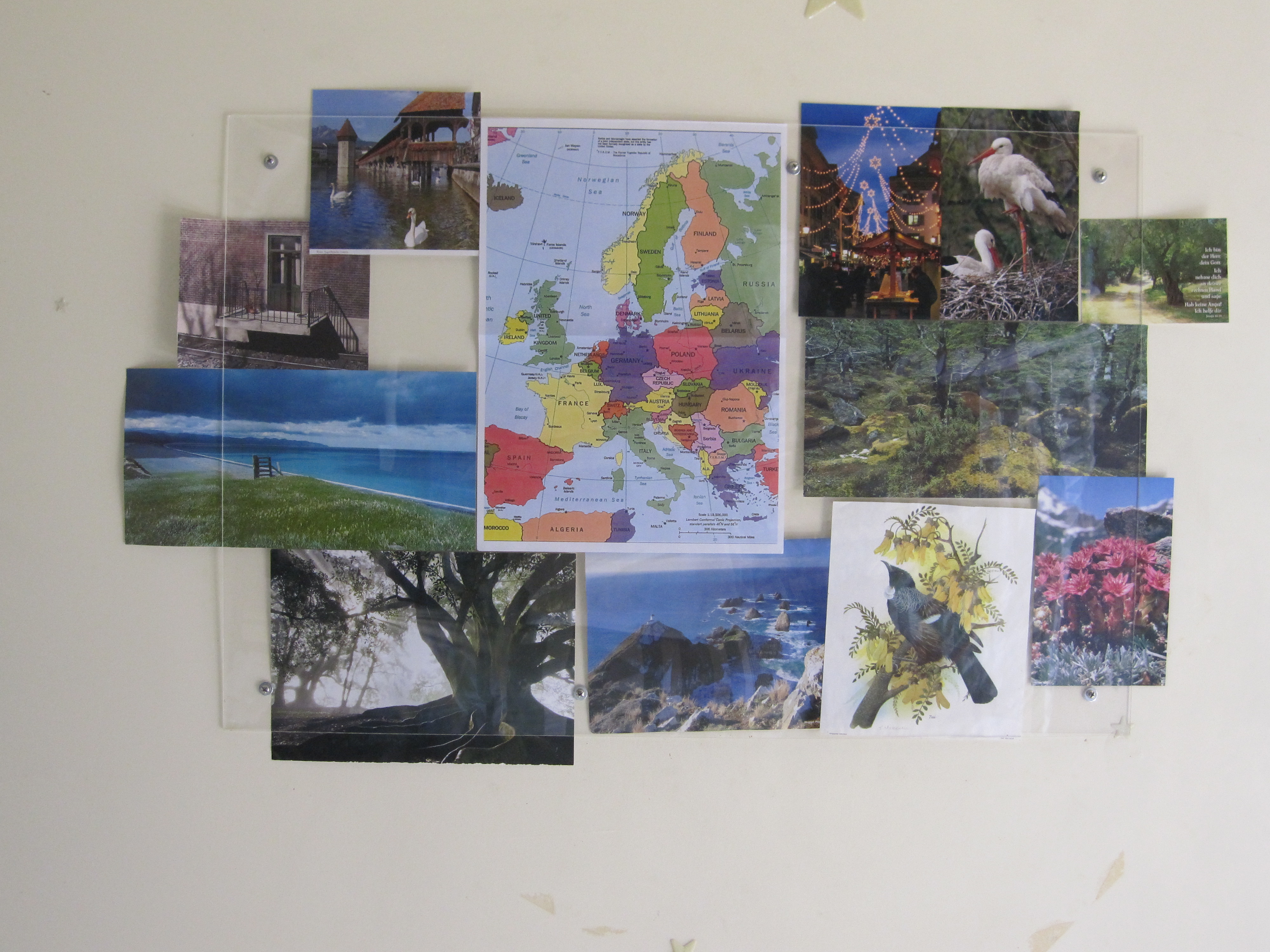
Lastly, I keep an ‘eye pillow’ beside my bed. When my eyes are tired I find its coolness very restful. I also use it to cover my eyes when I’m restless and fretful and it often helps me to settle. I made the eye pillow myself from satin loosely filled
with linseeds, but you can readily buy them online.
Personal care
Here are some tricks that I’ve learned that enable me to undertake most of my personal care myself.
Showering
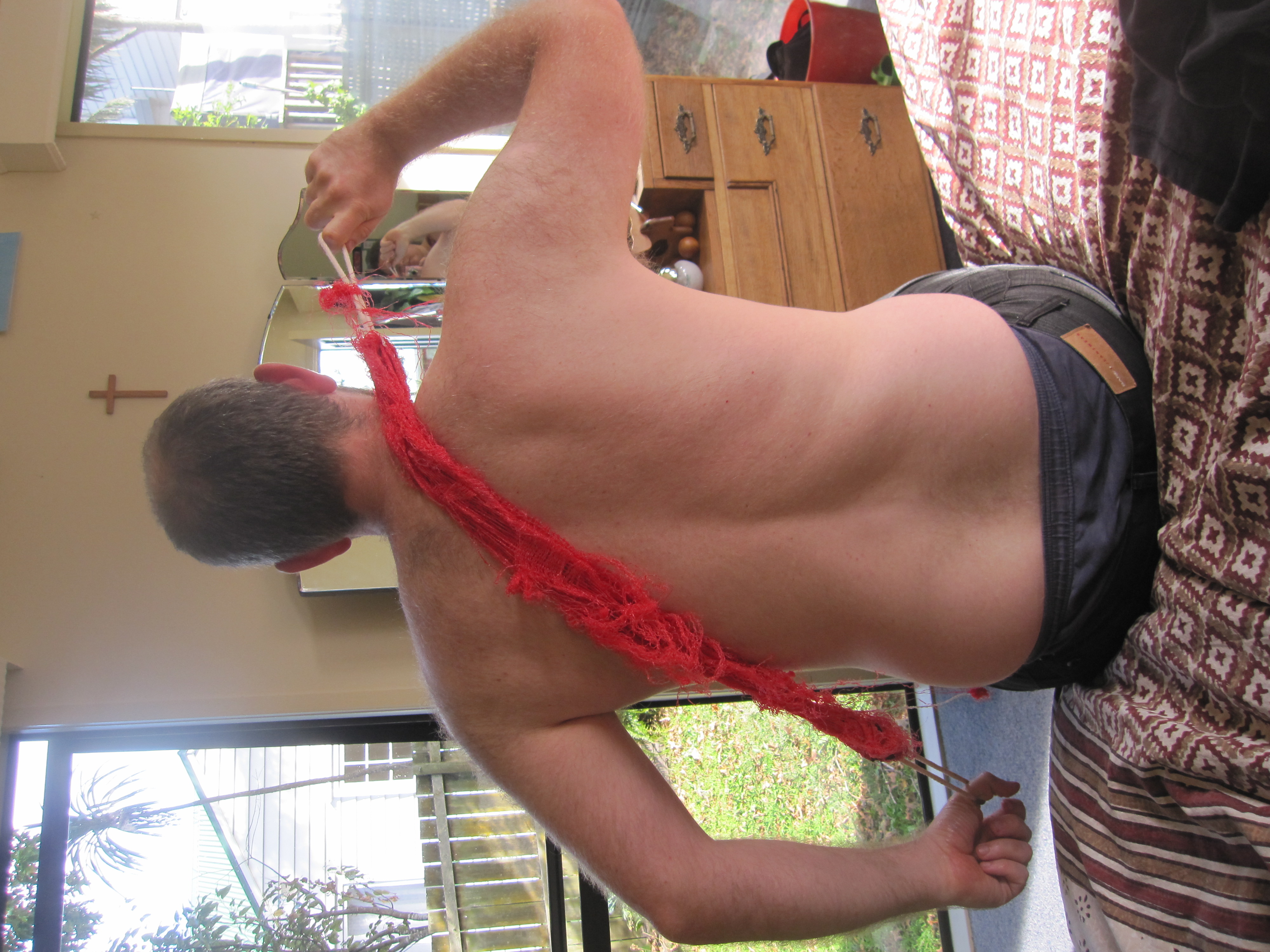
In order to manage my showering myself I've moved to showering only three times per week: it’s too exhausting to wash every day. I shower seated. I find it too hard to reach around behind myself to wash my back, so I made a scrubber from an old net onion
bag. I folded a 10kg onion sack (one without any labels glued to the mesh) lengthwise onto itself several times and stitching it to keep it into this position. I attached loops to each end through which I put my hands while I scrub it across my back.
I have found this much more effective and easier to use than commercial long-handled back scrubbers. It does gradually shed little pieces of the plastic mesh into the shower, though. One such back scrubber lasts me 4-5 years.
Hair washing
Hair washing used to be an exhausting task for which I frequently needed help. Treating my hair with coconut oil before every second wash has transformed this into a task I can usually accomplish on my own. I apply a tiny amount (around 1/8th of a teaspoon)
to a few spots on my hair, comb it through then wait 20 minutes before showering. In the shower I then wash my hair with shampoo.
How does this help? I no longer need anti-dandruff shampoo, and conditioner, so only have to lift my arms over my head once. I can usually manage that.
Look for 'fractionated' or 'deodorised' coconut oil if you don't want to smell of coconuts. You can but this at health food stores, or online at places that sell supplies for home soap making. It costs around $20 for a 200mL jar but that should last
you several years.
I once tried cutting my hair short (it’s naturally around waist-length) to see if that would make hair-washing easier. It was somewhat easier to wash than my usual long hair, but unfortunately needed to be washed twice as often. I’ve let it grow back
to its full length and again wash it once per week. I’m sure it helps that my hair is thick and doesn’t tangle easily!
Toileting in bed
Being able to toilet myself when I’m alone but unable to get out of bed (or think it would be best if I stayed in resting) has been fantastic. It means my husband is free to leave me home alone when he needs to, and I’m less likely to get distracted by
things I find around the house.
To make this possible I have a 'slipper' bed pan, two absorbent waterproof bed pads, around 25 reusable cloth wipes and a small bucket with a good lid. Here’s what I do.
When I need to use the toilet in bed, I roll to one side, spread an absorbent waterproof mat down where I was lying, roll back to where I was, pull down my underwear and slide a slipper bed pan under myself. If I need to do number twos I put the mat
down as before but kneel over the bed pan rather than lying on it. When the bedpan is not in use I store a roll of toilet paper inside it. I find that I use a lot more toilet paper when I’m using the bed pan so it’s important that there’s plenty!
I have two waterproof mats so that I can always have a clean one available. I bought them from
conni.co.nz
for around $50-$60 each. I air the mat (draped on my walker) after every use. When it starts to smell (after multiple uses) I pop that one in
the wash and get out the other one. It’s important not to fill the washing machine too full when you wash them: they’re stiff so they take up more room than you’d think. If I’m not well enough to manage laundry yet both mats are smelly I rub one of
them with plenty of baking soda to absorb the smell. I’ve had the mats for around 10 years now and they’re both still in excellent condition.
After I’ve used the bed pan, if I expect to get up before I next need the toilet I simply leave it on my walker to deal with when I'm up. Otherwise I tip the contents into a small three litre lidded pail: the kind of small bucket that Cookie Time Christmas
cookies come in. I always tip the contents of the bedpan into the bucket if it’s got faeces in it: otherwise the smell is bothersome. The Cookie Time bucket doesn’t have enough capacity for a whole day in bed: for that I use a proper bucket, also
with a good lid.
At the end of the day, if the bedpan has only been used for urine, my husband rinses it out and leaves it to drip dry in the laundry sink; if it’s been used for faeces as well he cleans it with toilet cleaner. My bedpan is a molded plastic slipper
pan with a lid. You can buy these from disability resource suppliers or some chemists for around $25-$40.
When I’m finished with the bedpan I clean my hands with wet wipes. I don’t like the smell of commercial wet wipes (even the nominally unscented ones) so I’ve cut reusable wipes out of soft, non-fraying towelling fabric instead. After use they get washed
in our ordinary laundry. As they come back from the wash I fold them in thirds (like folding a letter) and stack them in a 2L icecream container. When I’ve collected 20 of them I pour over them a solution of 1 ½ cups boiling water, 1T shampoo and
1 ½ tsp vinegar. When that's cooled on them I transfer them to a smaller container ready for use. I made about 25 of them so that I’d always have some still available for use while I’m accumulating the next 20 clean ones.
To be productive/engaged in bed
As mentioned earlier, I spend most of my day in bed. Some of this is spent 'special resting' (where I lie on my back and do absolutely nothing), but most of it is spent in low-grade activity. One tool I've found useful in this activity is the computer
typing programme
Dasher, described in it's own
article on this website. Here are some more things enable me to be active without wearing myself out too much.
Reaching stick
I have a long-handled reaching tool that I keep hooked over one of the handles of my walker. It has a handle at one end and jaws at the other end that squeeze shut when you squeeze the handle. I use it to pick up things that have fallen on the floor or
are simply a little out of reach. You can buy such devices from hardware stores, however I eventually opted for one designed for people with disabilities. Unlike the regular models, the disability version comes with a hook at the handle end so you can
easily stow it on a walker or wheelchair. The one I bought from Bunnings didn't have this and was always falling off my walker: I seemed to pick it up as often as I used it to pick things up!
I also find my reaching stick very useful for picking things up when I'm moving around the house.
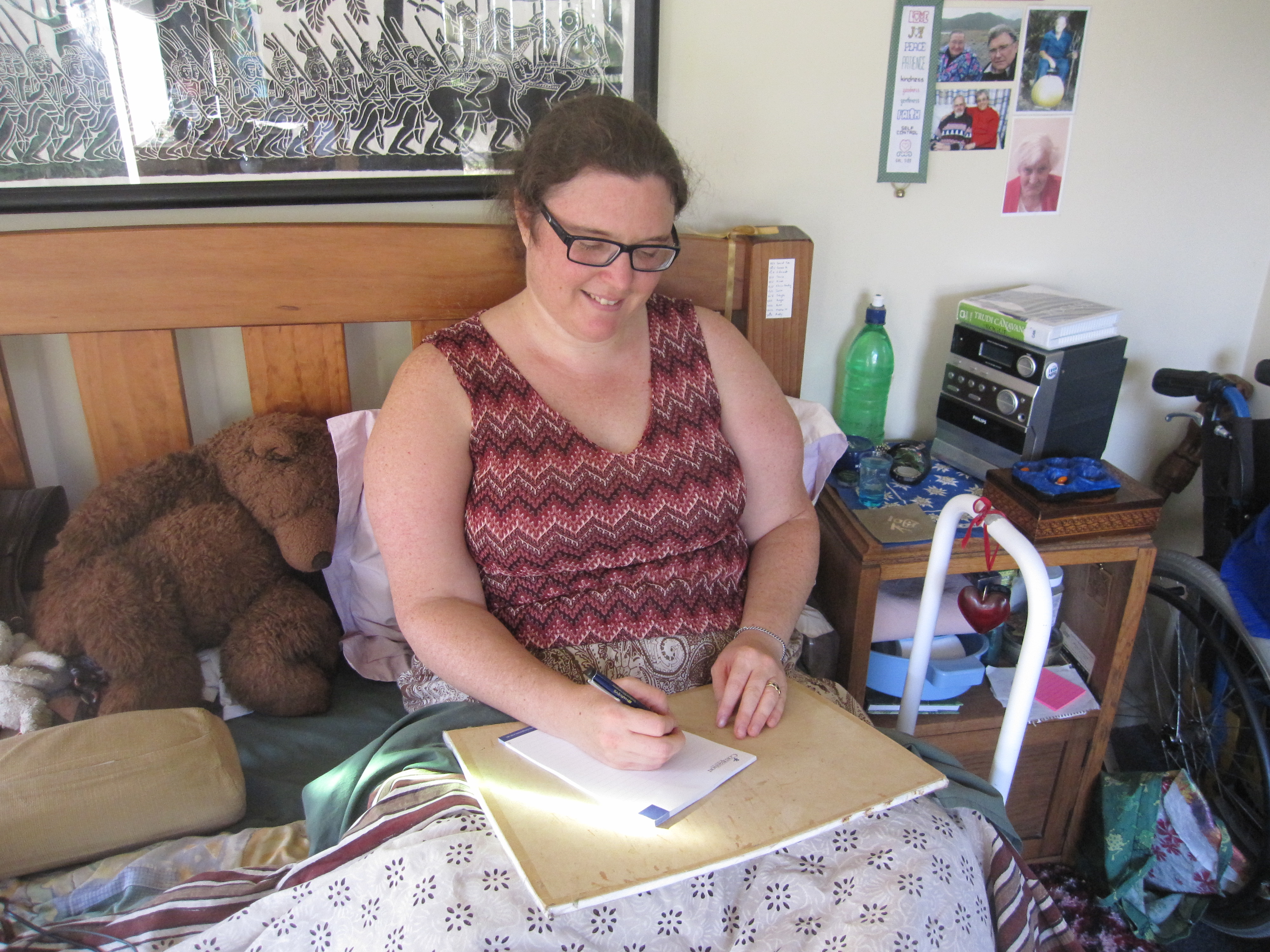
Writing board
Usually when I'm in bed I'm lying down, but sometimes I'm able to prop myself up and write. For this I use a writing board I've made from a piece of polystyrene (about 1cm thick) with firm cardboard taped on top. It's light and easy to hold but still
gives a firm writing surface.
Binoculars
I have a good, light-weight pair of binoculars that I keep next to my bed. These are great for watching the birds in the trees outside my windows and generally getting a better view of what's going on in the outside world.
To enjoy the outdoors
I don't often get out, but here are a few things that help me when I do! One further item is my 'wheelchair bike', described in it's own
article.
Enjoying the garden
My bedroom door opens straight onto our porch. Here my husband has hung hooks on which I can mount a hammock. It's not too hard to string the hammock onto the hooks: I can often do this myself. In the hammock I'm lying down so don't have trouble with
nausea from orthostatic intolerance and can simply swing in the breeze, muse and enjoy the birdsong!
I also have a 'banana chair' (or beach lounger chair) which we take with us whenever we go to the park or spend time with friends outside. I can lie completely horizontal if necessary, or the back section can be ratcheted up into a sitting position.
It enables me to be outside and to be part of the group without wearing myself out sitting up. I also take this with me whenever I go somewhere where I might need to sit for a considerable length of time: to weddings, funerals or even to visit friends
who don't have sofas long enough to properly lie down on.
Swimming
I've always loved swimming, but I no longer have the ability to get myself into the water or the muscle strength and control to keep me safe once there. I have two devices which help with this.
The first is a beach wheelchair in which I can be transferred from the car to the sea. You can buy commercial beach wheelchairs but they're extremely expensive (I think that they start at around $3000 or $4000). We've made our own from a regular beach
lounger chair and two special Wheeleez wheels: the same wheels used on commercial beach wheelchairs. They're wide wheels inflated at very low pressure which travel smoothly over sand and gravel. You can buy them from
beachwheels.co.nz.
Over the years
we've further improved it with a flotation cushion at the front (so it doesn't tip me straight into the sea as soon as the water is deep enough for the wheels to float) and a strap on the front with which my husband pulls it along. Our setup cost about
$500 – still not cheap, but cheaper than the commercial ones! Please
contact me
if you'd like some advice on making your own beach wheelchair or if you're in Auckland and would like to borrow ours to see how it works.
Secondly, I have a flotation aid that keeps me safe in the water without being held all the time. It is basically a ring, with a wide section on which I can lean and two arms that clip together to form a circle around my body. I made it out of strong
mesh fabric stuffed with old bean bag beans but I believe you can also buy these commercially.
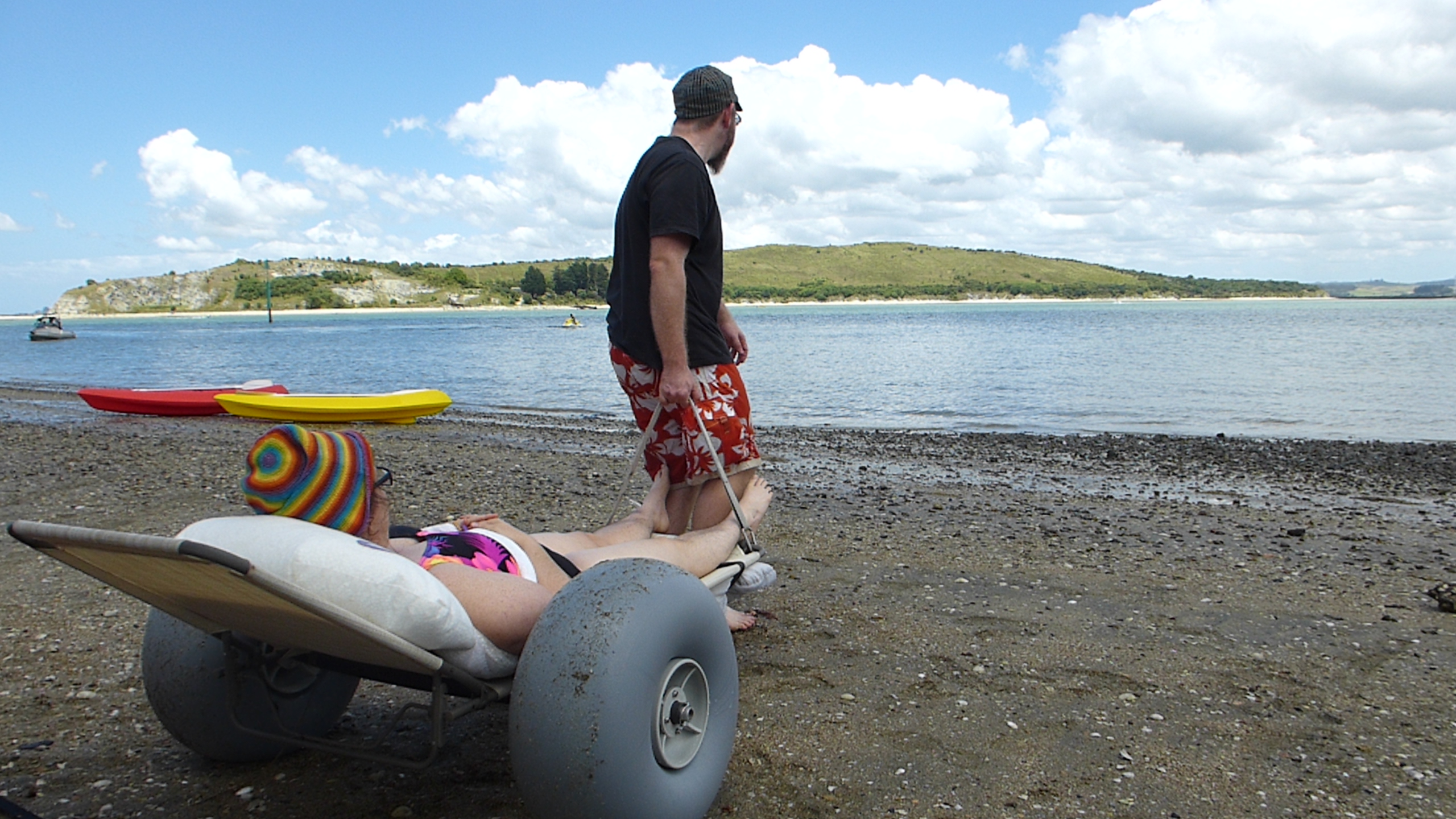

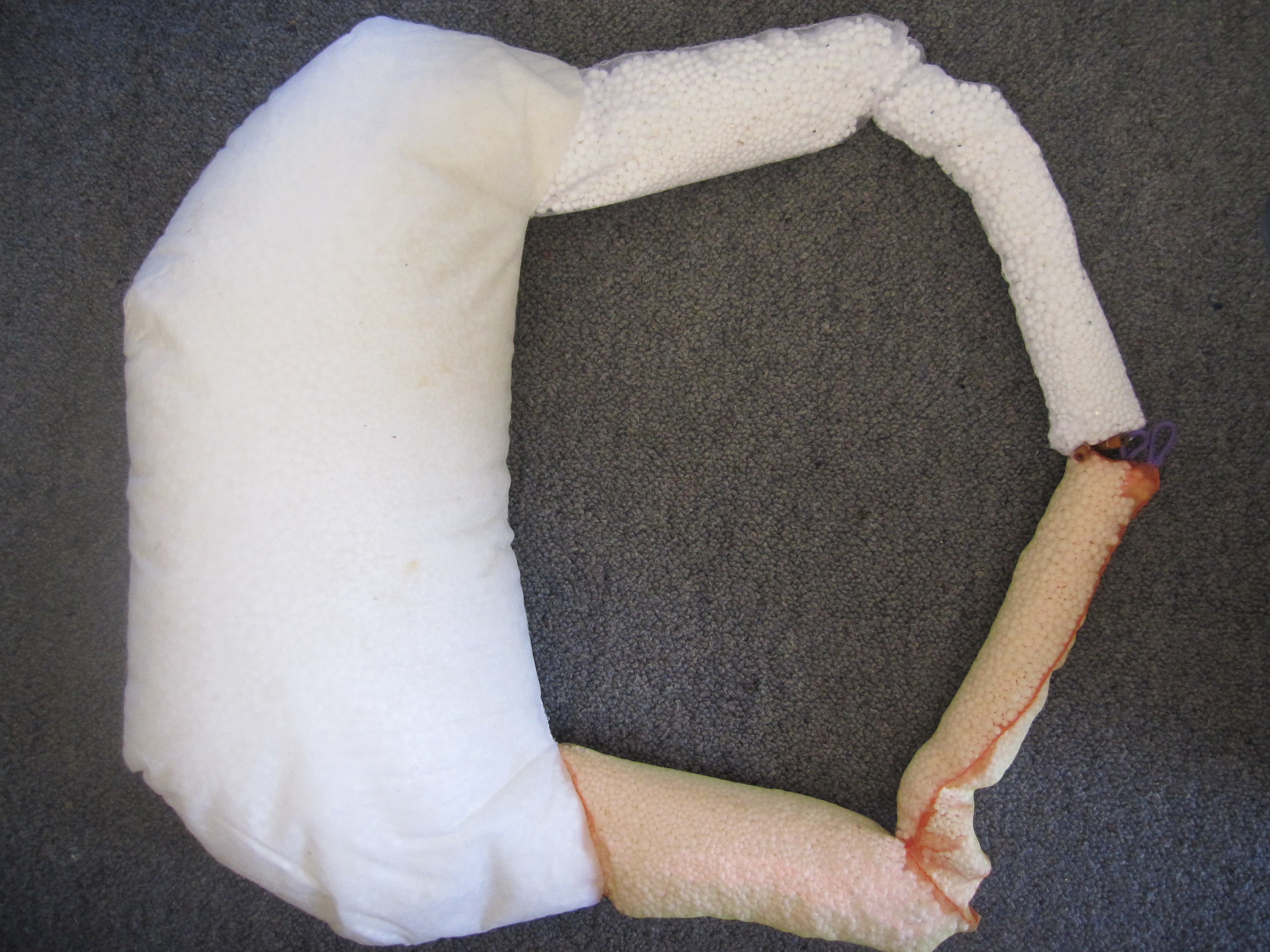
General energy saving
Finally, a few things that enable me to get through life in general without wasting energy unnecessarily!
Light-weight cutlery and plates
I only use plates and bowls made of bone china, melamine or wood. The bone china and wooden plates and bowls have all been bought relatively inexpensively second-hand; the melamine bowls came from Chinese supermarkets. They are all a lot lighter than
regular china so are less effort to hold and carry.
I also use light-weight metal cutlery. In general, the less metal cutlery is sold for the lighter it is, so look for your cutlery at junk shops! I find my light-weight cutlery so much easier to use than regular cutlery that I carry a set of it in my
handbag for use when I'm out and about.
Lists
I find it takes a lot of mental energy to figure out what I need to do in situations I encounter infrequently. To help with this, whenever I make a list of what I need in a situation that may come up again, I save a copy of that list on the computer for
next time.
I now have a master packing list for going away on holiday, a list of the preparations I need to make before my husband goes away on a respite break, a list of what I need if I'm going to be left alone on a day when I'm not strong enough to walk and
so on. These greatly reduce my stress as I approach these complicated, unfamiliar situations.
Phones
We have chosen to buy home phones that:
- are cordless, so that I can carry one with me on my walker all the time and so can call for help if I have a fall or otherwise get stuck;
- have an intercom function, so that I can easily call the other phone when I need help (a loud volume is helpful here!);
- have a speaker phone option, so that I don't need to hold the phone to my ear to talk;
- can store plenty of telephone numbers and have a redial function, so that I don't have to pick up and flip through a book to find the number I want.
We keep the ringer volume low on the phone I use, but high on the one in the more public part of the house.
I find these phones so useful that we have begun to take them with us whenever we go away. I'm quite clumsy and often drop them but we still find a pair generally lasts around 3 years. A new pair costs well under $100 on TradeMe.
Stools
I conserve energy by sitting as much as possible. We have stools in the kitchen and the bathroom so I can sit while preparing my lunch or brushing my teeth. I also chose a walker that includes a seat so I always have a seat with me if I need a quick rest.
I hope that you will have found some technologies here that will enable you, also, to live a more satisfying life with your limited reserves of energy!
Arohanui,
Heather
April 2014